
FR
/
EN
Introduction
-
Inspirations
-
Legends in love
-
Contemporary creations
-
Historic pieces
-
Visit
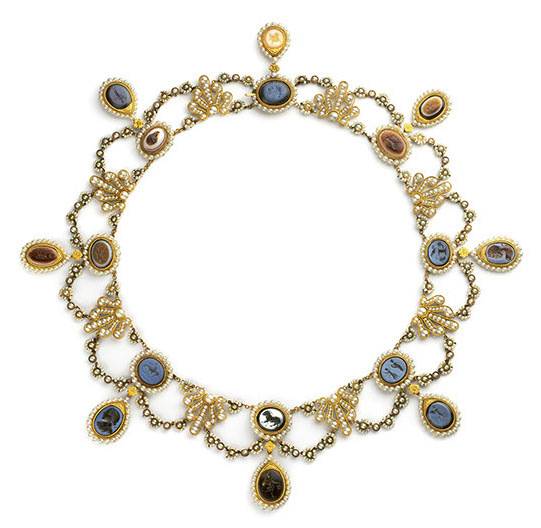
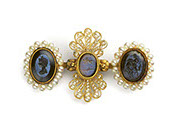
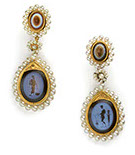
Set of intaglio jewellery
Chaumet - Nitot, circa 1805
For the love of an empire
Empress Joséphine was a tastemaker of her era with an exquisite sense of style. She brought cameos and intaglios, displayed in the cabinets of curiosity of the 18th century, back into fashion. She transformed the relics of the Roman Empire into fashion accessories, mounting them as delicately coloured jewels coordinated to match her dress. This set of intaglios, purposefully picked out by Joséphine and steeped in romantic symbolism, offers an overview of Roman mores. Diana is seen beneath a crescent moon that symbolises fertility and beauty. She is juxtaposed with Mercury, winged messenger and Roman god of love and luck as depicted by Veronese. Beneath this winged liberty is Fortuna, goddess of luck and fertility. A bust of a satyr – an illustration of Dionysian luxury – and a Bacchante nymph evoke the pleasures of the flesh and merry-making. Last but not least, two cupids are represented at the centre of the brooch. Joséphine loved to point out the mythical figures and explain their meanings.

Historic pieces, treasures of the heart
Spelling out love
Acrostic jewellery conceals a hidden love poem in the initials of the gemstones. Napoléon, a loving husband, son and brother, gave these bracelets as wedding and birthday gifts to the Empresses Joséphine and later Marie-Louise, to his mother Madame Mère and to his sister Elisa Bacchioci. Chaumet has regularly reinterpreted acrostic jewels over time, sometimes embellishing them with ribbons and other sentimental touches.

AMOUR bracelet with ribbons
Joseph Chaumet, circa 1890

AMOUR bracelet
Chaumet, 2004
Sealed with a kiss
This delicate bracelet criss-crossed with kisses and steeped in sentiment is inspired by the hidden love poems of acrostic chain bracelets and the bow motif, an important element of style for Chaumet jewellery.

Multi Liens bracelet
Chaumet, 2007
Micro Liens ring
Chaumet, 1989
Ring with bat motif
Joseph Chaumet, circa 1900
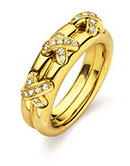
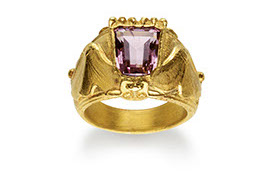
Lasting love
Mysterious bliss
In this curving tribute to Chaumet’s 1977 Premiers Liens collection, two rings are united with criss-crossing diamond ties. A romantic promise to bind two lives together forever.
This Art Nouveau signet ring features a mysterious and unexpectedly romantic motif. The bat is in fact a symbol of fecundity, and in the Far East is associated with happiness and longevity. Pliny the Elder even attributed erotic and aphrodisiac powers to this creature of the night.
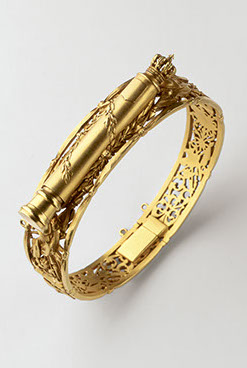
Pencil holder bracelet
Joseph Chaumet, circa 1890
Peal of friendship
Russians traditionally exchange Easter gifts of bell or egg charms as a symbol of friendship and new life. This carved rock crystal bell is worn as a pendant on an enamelled chain.
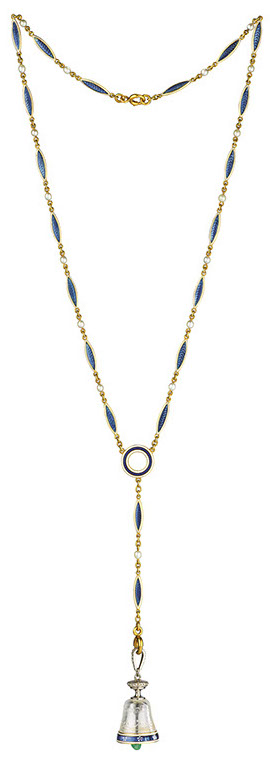
Bell pendant
Joseph Chaumet, 1911
Cannon motif
This central motif, depicting a marshal’s baton encircled by laurels and surmounted by the Bourbon crown, originates in carved gold military trophies. This bracelet presents the motif within a wreath of ribbons and bows. It was commissioned as a wedding gift to mark a marriage between the House of Orléans and industrial dynasty Schneider.

Forget-me-not watch
Joseph Chaumet, 1908
Forget-me-not
The tiny flowers embellishing the dial of this watch say “forget-me-not” and are a universal love message. Hidden from view within the dial is a portrait of the object of affection. This mysterious watch is thought to have been commissioned by the Marquis of Montesquiou.
Cupid’s arrow
Cupid never misses, and his arrow strikes this ladies’ watch right on target, pointing up to the heavens in a dazzling ray of light. The guilloché enamel timepiece, daintily framed in a ring of platinum lace, may be worn as a pendant, or pinned on the corsage.
Pendant watch and arrow pin
Joseph Chaumet, circa 1910
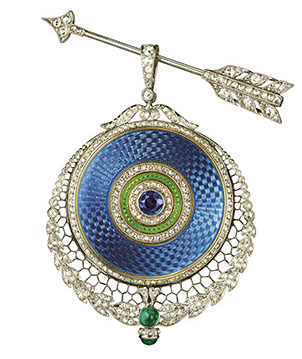

NAPOLÉON TO JOSÉPHINE
Cherasco, 10 Floréal, Year IV (29 April 1796)
"My happiness is that you be happy; my joy, that you be gay; my pleasure, that you should have pleasure. Never has a woman been loved with more devotion, passion and tenderness.”
Cross my heart
The parallel lines of a slender ribbon knotted here and there run alongside the pure simplicity of rows of criss-crossed sapphires and diamonds in alternating colours. These supple Belle Époque bandeaux, which can also be worn as necklaces, are fastened with a velvet cord.

Criss crossed ribbon bandeau
Joseph Chaumet, circa 1900
Love conquers all
This tiara, a flourish of ribbons, bows and classic 18th century floral and leaf motifs, celebrates victory and accomplishment. The crimson tones of generous oval-shaped topazes suggest raptures of emotion.
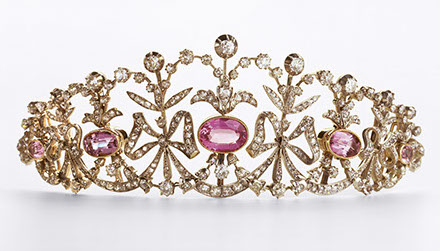
Bowknot tiara
Joseph Chaumet, circa 1890
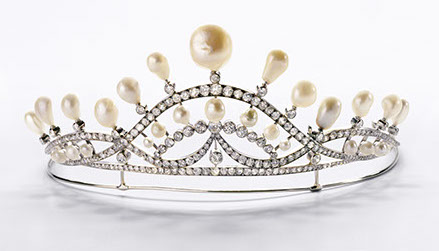
Curvilinear tiara
Joseph Chaumet, circa 1930
Aphrodite’s spell
The feminine curves of the pearl are associated with Venus, goddess of love, making it a popular choice for wedding jewellery. In this piece, the sensuous contours of natural baroque pearls are arranged in delicate twirls of ribbons to powerful effect.
Blossoming love
Descendant of Louis XIV, brother of Empress Zita of Austria, Prince Sixte of Bourbon-Parma married Hedwige de la Rochefoucauld in 1919. For the corbeille de mariage, the mother of the bride, the Duchess of Doudeauville, ordered from Chaumet a set of jewellery which was delivered on the morning of the wedding, 12 November 1919. Included was this tiara, a masterpiece of lace-like platinum and diamonds decorated with stylised fuchsias whose stamens appear to quiver, lifelike. It is a fine example of Chaumet’s art of trompe-l’oeil; the pear-shaped motifs are defined by cushion-cut diamonds punctuated with brilliant-cut diamonds.
Bourbon-Parme tiara with fuchsia motifs - Joseph Chaumet, 1919
Evening lace
This masterpiece of the Belle Époque was commissioned by the Duke of Rohan as a wedding gift for his daughter. The fully articulated lattice of platinum makes for an impressively lightweight choker made to grace an elegant throat exposed by the daring décolleté of an evening gown.

Openwork choker necklace
Joseph Chaumet, 1906
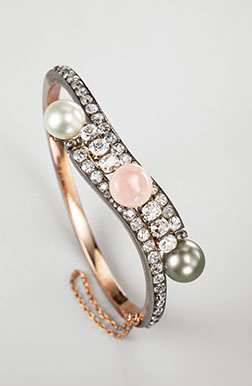
Three pearls bracelet
Joseph Chaumet, circa 1895
Perfect harmony
The centrepiece of this diamond double bangle is a round pink conch pearl whose rare forms were prized in the Belle Époque. This Toi & Moi treasure is flanked by a white pearl and a grey pearl in symmetry of form and colour.
Flourish of love
The glitter of diamonds meets the shimmer of pearl in a gleam of perfect harmony. The bow, securely tying the bond of commitment, also begs to be unravelled behind closed doors. This finely wrought flourish of love’s fulfilment adorns the bust.
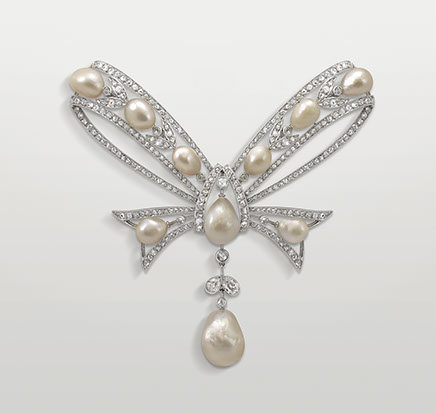
Bowknot corsage brooch
Joseph Chaumet, 1922
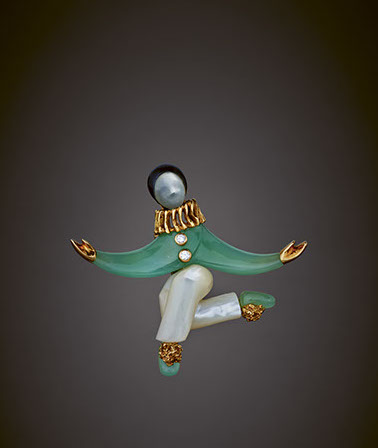
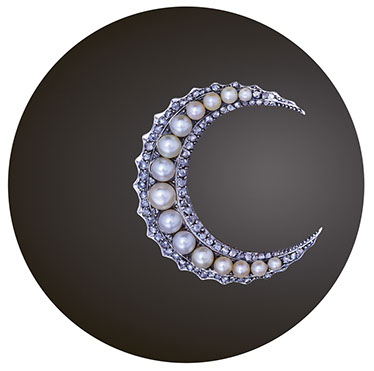
Moon crescent brooch
Joseph Chaumet, circa 1880
Pierrot brooch
Béatrice de Plinval for Chaumet, 1970
Face of the moon
Queen of the night
This brooch deftly depicts the innocence of Pierrot, the gentle hero of the Comedia dell’Arte who is hopelessly in love with the capricious Colombine. Moonstone - used here to show the character’s whiteface - is traditionally exchanged by lovers as a token of commitment.
The shimmer of the pearl is as fleeting and changeable as the moon, its feminine curves fecund with promise. These pearl-set crescents gleamed like queens of the night in Belle Époque hairstyles, lighting up the twilight at the hour when dreams would awaken.

NAPOLÉON TO JOSÉPHINE
Pistoja, Tuscany, 8 Messidor, Year IV (26 June 1796)
“Farewell my dear love, a kiss on your mouth; another on your heart, and another on your little...”
Soaring to the heavens
The sky was the limit for Joseph Chaumet as he created infinite permutations of winged jewellery. His flock of aigrettes – which could also be worn as brooches – featured removable wings that could be pointed in different directions. Captured mid-flight in all styles, shapes and sizes, these feathered adornments defined the Belle Époque.

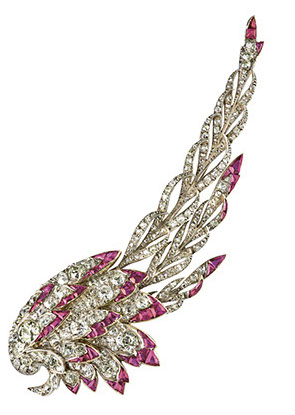
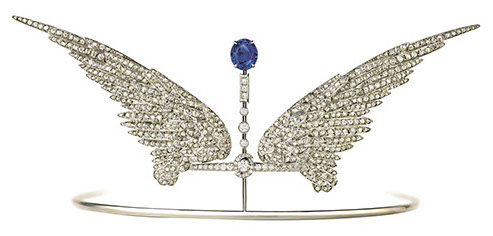
Pair of wings brooches
Joseph Chaumet, 1908
Wing brooch
Joseph Chaumet, circa 1909
Titrer Wings aigrette
Wings: Joseph Chaumet, circa 1915
Aigrette setting: Chaumet, 2011
This imposing pair of wings was mounted on an aigrette for American heiress Gertrude Vanderbilt, whose marriage to Harry Payne Whitney had brought together two fabulously wealthy families. A student of sculpture under Rodin, the founder of Vogue magazine and an avid collector, Vanderbilt was above all an artist. She opened the Whitney Museum in New York to express her passion for creativity. Her bold character and confidence translated into a fearless taste in jewellery.
Among myriad pieces by Chaumet, she also owned a second pair of diamond wings. In this pair, the taut rows of diamonds contrast with the translucent curves of blue enamel.
This pair of diamond brooches has been mounted in an aigrette setting that is faithful to their Belle Époque origins. The wings can be pointed in different directions. The feathers are meticulously crafted and layered in a display of exacting skill on the part of the jeweller.